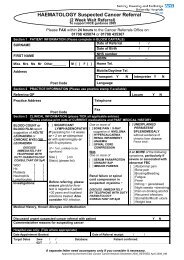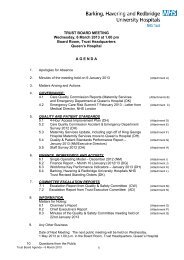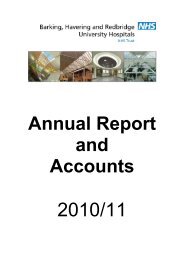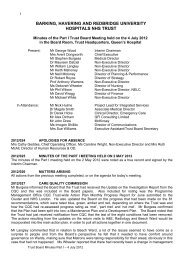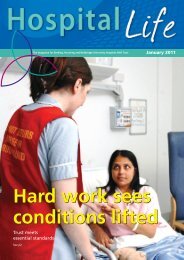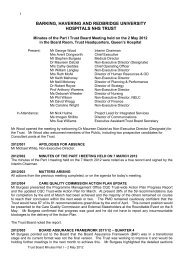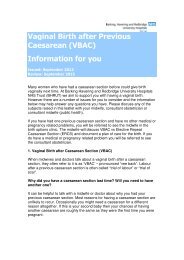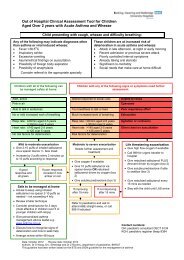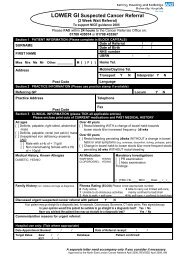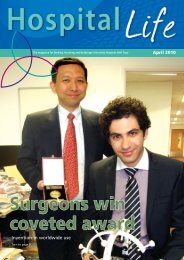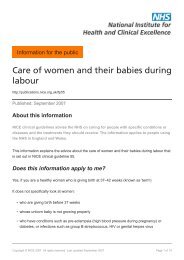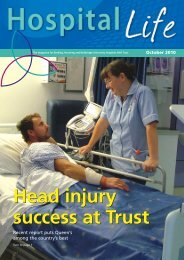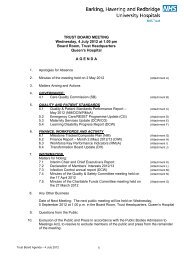Trust Board papers November 2012 - Barking Havering and ...
Trust Board papers November 2012 - Barking Havering and ...
Trust Board papers November 2012 - Barking Havering and ...
Create successful ePaper yourself
Turn your PDF publications into a flip-book with our unique Google optimized e-Paper software.
The Statutory Safety Committee, a feeder committee of the Audit Committee, has specific<br />
responsibility for ensuring risks to patients, staff <strong>and</strong> visitors are managed robustly. The Statutory<br />
Safety Committee takes reports on Health, Safety & Fire, Major Incident & Emergency Planning,<br />
Safety Alerts, health & safety key performance indicators, Manual H<strong>and</strong>ing <strong>and</strong> Radiation issues,<br />
<strong>and</strong> approval of risk policies.<br />
Any risks identified by the Audit Committee are reported to the <strong>Trust</strong> <strong>Board</strong> for information /<br />
action. The Committee’s full terms of reference are available on the <strong>Trust</strong> Intranet.<br />
4.2 STRATEGIC OBJECTIVES<br />
BHRUT has St<strong>and</strong>ing Orders, St<strong>and</strong>ing Financial Instructions <strong>and</strong> a Scheme of Delegation, which<br />
include the roles <strong>and</strong> responsibility of its sub-committees. BHRUT’s risk management processes<br />
aim to ensure:<br />
• There is a common framework within which risks are identified <strong>and</strong> assessed via the Risk<br />
Assessment Tool Kit for inclusion in the <strong>Trust</strong> Risk Register.<br />
• Risks to the effective functioning of the <strong>Trust</strong> in its principal objectives are systematically<br />
<strong>and</strong> consistently identified.<br />
• Action plans are in place to prevent or mitigate the adverse effects of identified risks.<br />
• Obstetric risks are managed through the Maternity Risk Management Strategy<br />
• All other risks, including financial risks, are identified, managed <strong>and</strong> audited through the<br />
<strong>Trust</strong>'s risk management procedures<br />
• Action is taken to manage identified risks so that they are kept to an acceptable level.<br />
• There is recognition that innovation <strong>and</strong> improvement within the wider NHS has to include<br />
an element of risk.<br />
• The Risk Management Strategy/Policy is communicated to all staff <strong>and</strong> is embedded in<br />
everyday practice.<br />
• The Risk Management Strategy <strong>and</strong> policy is available to the public <strong>and</strong> other<br />
stakeholders.<br />
4.3 TRUST RISK MANAGEMENT APPROACH<br />
This <strong>Trust</strong> will approach the management of risk from two aspects:<br />
• Strategic Risks<br />
• Operational Risks<br />
Strategic risks are considered as:<br />
Those business risks that if realised, could fundamentally affect the way in which the organisation<br />
conducts its business financially <strong>and</strong> complies with the Health <strong>and</strong> Social Care Act 2008<br />
st<strong>and</strong>ards. Strategic risks will have a detrimental effect on the achievement of the key business<br />
objectives. Strategic risks are detailed in the <strong>Trust</strong> <strong>Board</strong> Assurance Framework <strong>and</strong> are mapped<br />
against the <strong>Trust</strong>s strategic objectives.<br />
Operational risks are considered as:<br />
Those risks associated with the delivery of the key business processes <strong>and</strong> the delivery of patient<br />
care in a safe environment. Issues arising from operational risk assessments will be considered at<br />
Directorate level <strong>and</strong> escalated through the directorate structure before these are reported on the<br />
<strong>Trust</strong> Corporate Risk Register. Operational risks can include:<br />
• Clinical risks: risks associated with the inpatient, day case, outpatient <strong>and</strong> diagnostic<br />
activities of the <strong>Trust</strong>.<br />
• Non-clinical risks: risks associated with the environment of care e.g. use of the building<br />
<strong>and</strong> facilities by staff, patients, contractors <strong>and</strong> other visitors; health <strong>and</strong> safety risks; staff<br />
management; availability <strong>and</strong> use of information.<br />
<strong>Barking</strong>, <strong>Havering</strong> & Redbridge University Hospitals NHS <strong>Trust</strong> Page 11 of 40<br />
????????????? ??/??/???? Version ?? Issued ????



![[4] Biopsy Leaflet.pub - Barking, Havering and Redbridge University ...](https://img.yumpu.com/51285530/1/190x134/4-biopsy-leafletpub-barking-havering-and-redbridge-university-.jpg?quality=85)

